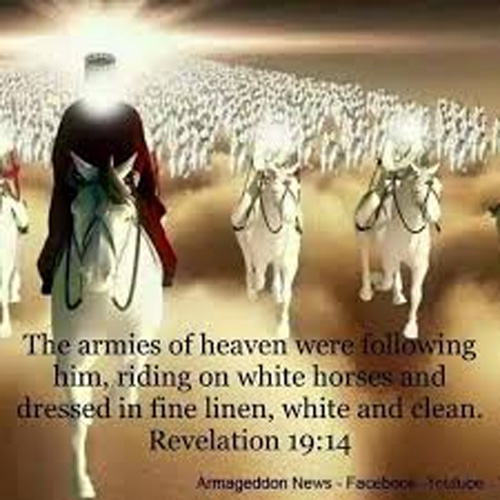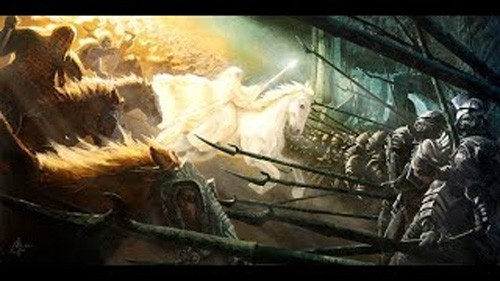
Below: Gandalf arrives (on the third day) to rescue Helm’s Deep from the armies of Sauron.
It is fairly well recognized in Christian circles that J.R.R. Tolkien’s masterpiece, “The Lord of the Rings,” is in many ways allegorical of Christian themes. Supposedly, Tolkien, C.S. Lewis and Frank Herbert had some sort of informal agreement to each write a trilogy rooted in a Christian religious theme. Lewis’ “Chronicles of Narnia” came closest to the mark, being a direct Christian allegory and Herbert’s “Dune” trilogy obviously fell far short (a view shared by Tolkien himself, supposedly). Tolkien’s own effort, influenced by a strong friendship with Lewis, hewed a middle path.
Peter Jackson’s film adaptation of “The Lord of the Rings” preserved many elements of the Christian allegory – the most obvious being the war of good and evil in the world that drives the story, and the unmistakable personification of Satan in the character Sauron. The great climax of the trilogy is clearly Tolkien’s version of the War of Armageddon.
Christ imagery in the film is most dramatically linked to the wizard Gandalf in “The Two Towers,” when (“on the third day”) in blinding white garments he appears on the crest of the ridge overlooking the valley of Helm’s Deep with the “host of heaven” and a blazing sunrise at his back, and then sweeps down the mountainside in a flood of unstoppable righteous vengeance against the wicked.
There’s plenty of “literary license” being taken there, but the imagery is straight out of Revelation 19:11: “Then I saw heaven standing open, and there before me was a white horse. And its rider is called Faithful and True. With righteousness He judges and wages war. He has eyes like blazing fire, and many royal crowns on His head. … The armies of heaven, dressed in fine linen, white and pure, follow Him on white horses. And from His mouth proceeds a sharp sword with which to strike down the nations. … He treads the winepress of the fury of the wrath of God the Almighty. And He has a name written on His robe and on His thigh: KING OF KINGS AND LORD OF LORDS.”
Of course, Hollywood must always defile the telling of the Gospel, and so Jackson’s version features Ian McKellen, an aggressive homosexual political activist (and groomer of schoolchildren) in the role of Gandalf.
However, the true Christ figure in “The Lord of the Rings” is not Gandalf but Aragorn (played by Viggo Mortensen), a character whose storyline mixes elements of Christian theology with those of British Israelism, a fact best encapsulated in the title of the final book “The Return of the King” (Isildur’s heir).
The most obvious aspect grounded in basic Christian theology is the theme of the second coming of Christ as King of Kings. Through most of the trilogy, Aragorn displays Christlike humility and devoted service to the cause of protecting humanity from evil, always soft-spoken and kind-hearted but unwavering in his righteous cause, like Jesus during his first coming. Only at the end is Aragorn revealed to be the “high king” (king of kings) foretold by prophecy, who then leads the armies of righteousness against the legions of Sauron/Satan.
A second major aspect, common to both traditional Christian theology and to British Israelism, is the theme of a prophesied Millennial Kingdom that follows the War of Armageddon. The coronation of Aragorn occurs only after the conquest of the wicked, amidst many symbols of millennial harmony – a scene much more extensive in the book than in the film.
But a third major aspect, central to British Israelism and unrecognized by most Christians, is the theme of an interrupted royal succession in which the throne is held for long ages of time by a “steward” (the steward of Gondor) awaiting the return of the true king. Indeed, there is a long succession of stewards that began when “Isildur conferred rule of Gondor upon Anárion’s son Meneldil, retaining suzerainty over Gondor as High King of the Dúnedain.”
To be clear, I do not endorse British Israelism, which has been largely debunked and become the subject of much ridicule over the past century. BUT very importantly, it is a doctrine that was so enormously influential in Great Britain from the 16th century through the very early 20th century that I contend it is impossible to understand the rise and rule of the British Empire without knowing BI’s history among the elites. What matters most is not whether BI is true, but that key elites believed it to be true and for hundreds of years set world-shaping policy based in part upon that belief.
The essence of BI doctrine is this: In Genesis 49:10, the patriarch Jacob prophesied that a Hebrew monarchy would arise under his son Judah, to wit, “The scepter will not depart from Judah, nor the staff from between his feet until Shiloh [Christ] comes and the allegiance of the nations is his.” Judah had two sons, Zerah and Perez, and the monarchy was vested in the Perez line beginning with David and ending with Jesus (Matthew 1:3-16).
When the Perez line was supposedly terminated by Nebuchadnezzar’s murder of King Zedekiah and all his male heirs (Jeremiah 39:6-7), Jeremiah took the kings daughters (who did in fact survive, per Jeremiah 43:5-6) to Ireland where the alternate Judean royal line of Zerah had supposedly migrated generations before. Thus, BI theory contends, unbroken royal succession continued by marriage of the two royal lines, and expanded to Scotland and then Great Britain, memorialized by the “Stone of Scone” (“Jacob’s pillow”), which literally sits on a shelf under the seat of the official throne to this day.
At Christ’s first advent, Jacob’s “Shiloh” prophecy was fulfilled in part – ending the line of true royalty – but converting the British monarchy into stewards awaiting the return of the true king, Christ, and the prophecy’s total fulfillment in the Millennial Kingdom when “the allegiance of the nations will be His.”
Laugh if you must, but this is the very belief that from the late 1500s onward united certain Jews (Elves), Scottish Protestants (Dwarves) and the British millennialists (Men) in British-Israelism influenced policy that culminated (during Tolkien’s formative years) in the world-shaking liberation of the Holy Land from the Ottoman Turks (Orcs) in 1917 and the subsequent repatriation of the Jews there.
And, bizarrely, Tolkien’s high fantasy seems coincidentally (or perhaps prophetically) to have foreshadowed the British monarchy today in that the final Steward of Gondor was Denethor (King Charles), whose wife Finduilas (Princess Diana) bore him two heirs, Boromir (Prince William) and Faramir (Prince Harry) before dying during their childhood (as did both Finduilas and Diana), and who reigns under the menacing shadow of a powerfully ascendant, deeply malevolent Mordor (the emerging Antichrist Kingdom).




